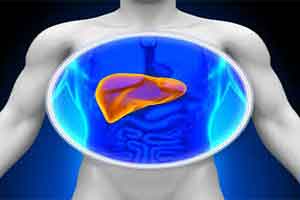- Home
- Editorial
- News
- Practice Guidelines
- Anesthesiology Guidelines
- Cancer Guidelines
- Cardiac Sciences Guidelines
- Critical Care Guidelines
- Dentistry Guidelines
- Dermatology Guidelines
- Diabetes and Endo Guidelines
- Diagnostics Guidelines
- ENT Guidelines
- Featured Practice Guidelines
- Gastroenterology Guidelines
- Geriatrics Guidelines
- Medicine Guidelines
- Nephrology Guidelines
- Neurosciences Guidelines
- Obs and Gynae Guidelines
- Ophthalmology Guidelines
- Orthopaedics Guidelines
- Paediatrics Guidelines
- Psychiatry Guidelines
- Pulmonology Guidelines
- Radiology Guidelines
- Surgery Guidelines
- Urology Guidelines
Inactivating certain protein-coding gene promotes liver tissue regeneration

Washington: A recent study says that inactivating a certain protein-coding gene promotes liver tissue regeneration in mammals.
"This research gives us ideas about new ways to treat liver damage or chronic liver disease," said senior researcher Dr. Hao Zhu of Children's Medical Center Research Institute.
Tails in lizards and arms in starfish show an astounding ability to regrow, but mammals have partially lost the capacity to extensively regenerate body parts, Dr. Zhu said.
The liver is unique among human solid organs in its robust regenerative capability. A healthy liver can regenerate up to 70 percent of its tissue after injury, he explained.
However, when the liver has been repeatedly damaged, by chemical toxins or chronic disease, it loses its ability to regenerate.
The Zhu laboratory studies both regeneration, when cells proliferate to repair an organ, and cancer, when cells proliferate out of control.
The National Cancer Institute (NCI) reports that liver cancer deaths increased at the highest rate of all common cancers from 2003-2012.
In addition to cirrhosis, risk factors for liver cancer include infections caused by the hepatitis C virus (HCV), liver damage from alcohol or other toxins, chronic liver disease, and certain rare genetic disorders.
Dr. Zhu began his investigation by studying a mouse that lacked Arid1a, the mouse version of a gene associated with some human cancers.
Based on this association, the researchers hypothesized that mice lacking Arid1a would develop liver damage and, eventually, liver cancer. They were surprised when the opposite proved to be the case - no liver damage occurred. In fact, livers of the mice regenerated faster and appeared to function better, he added.
On observation, livers in the mice without the gene appeared healthier. Blood tests confirmed improved liver function. When researchers deleted the gene in mice with various liver injuries, they found that the livers replaced tissue mass quicker and showed reduced fibrosis in response to chemical injury. Also, other tissues such as wounded skin healed faster in Arid1a-deficient mice.
No drugs are currently available to mimic a lack of this protein, although the researchers are using a grant from the Cancer Prevention and Research Institute of Texas (CPRIT) to search for one.
"This research gives us ideas about new ways to treat liver damage or chronic liver disease," said senior researcher Dr. Hao Zhu of Children's Medical Center Research Institute.
Tails in lizards and arms in starfish show an astounding ability to regrow, but mammals have partially lost the capacity to extensively regenerate body parts, Dr. Zhu said.
The liver is unique among human solid organs in its robust regenerative capability. A healthy liver can regenerate up to 70 percent of its tissue after injury, he explained.
However, when the liver has been repeatedly damaged, by chemical toxins or chronic disease, it loses its ability to regenerate.
The Zhu laboratory studies both regeneration, when cells proliferate to repair an organ, and cancer, when cells proliferate out of control.
The National Cancer Institute (NCI) reports that liver cancer deaths increased at the highest rate of all common cancers from 2003-2012.
In addition to cirrhosis, risk factors for liver cancer include infections caused by the hepatitis C virus (HCV), liver damage from alcohol or other toxins, chronic liver disease, and certain rare genetic disorders.
Dr. Zhu began his investigation by studying a mouse that lacked Arid1a, the mouse version of a gene associated with some human cancers.
Based on this association, the researchers hypothesized that mice lacking Arid1a would develop liver damage and, eventually, liver cancer. They were surprised when the opposite proved to be the case - no liver damage occurred. In fact, livers of the mice regenerated faster and appeared to function better, he added.
On observation, livers in the mice without the gene appeared healthier. Blood tests confirmed improved liver function. When researchers deleted the gene in mice with various liver injuries, they found that the livers replaced tissue mass quicker and showed reduced fibrosis in response to chemical injury. Also, other tissues such as wounded skin healed faster in Arid1a-deficient mice.
No drugs are currently available to mimic a lack of this protein, although the researchers are using a grant from the Cancer Prevention and Research Institute of Texas (CPRIT) to search for one.
Cancer Prevention and Research Institute of TexasChildren's Medical Center Research InstituteHepatitis C virusliver tissue regeneration
Source : ANINext Story
NO DATA FOUND

Disclaimer: This site is primarily intended for healthcare professionals. Any content/information on this website does not replace the advice of medical and/or health professionals and should not be construed as medical/diagnostic advice/endorsement or prescription. Use of this site is subject to our terms of use, privacy policy, advertisement policy. © 2020 Minerva Medical Treatment Pvt Ltd